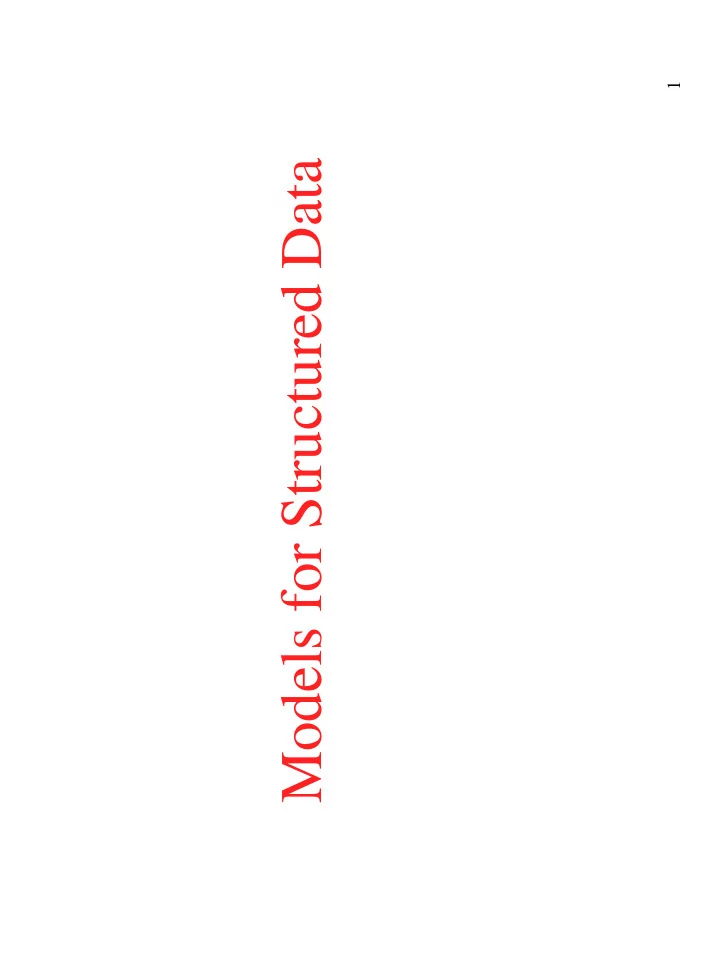

1 Models for Structured Data
Linear Chains • If we take a person’s BP every five minutes over a 24 hour period then there is some significant dependence between successive values • How to model this dependence? • Occurs in protein sequences, time series (measurements ordered in time) image data (measurements defined on a spatial grid) 2
First Order Markov Model • Structure of the data suggests a natural structuring of models we will build • T data points observed sequentially y 1 ,.., y T T ∏ = p ( y ,.., y ) p ( y ) p ( y | y ) − 1 T 1 1 t t t 1 = t 2 3
Generative interpretation of Markov Model T ∏ = p ( y ,.., y ) p ( y ) p ( y | y ) − 1 T 1 1 t t t 1 = t 2 y’ s instead of x ’s First value chosen by drawing a y 1 value randomly according to initial distribution p(y 1 ) Value at time t = 2 chosen according to the conditional density function p(y 2 /y 1 ) y 3 is generated according to p(y 3 /y 2 ) 4
Markov model limitation • Influence of the past is completely summarized by the value of Y at time t-1 • Y does not have any long-range dependencies • This model may not be accurate in many situations – In modeling English text, where Y takes on values such as verb, adjective, noun, etc, deciding whether a verb is singular or plural depends on the subject of theverb which may be much further abck than just one word back 5
Real-valued Y • Markov model is specified as a conditional Normal distribution Deterministic function Linking the past y t-1 to present y t − − 2 ⎛ ⎞ 1 1 y g ( y 1 ) = − ⎜ ⎟ t t p ( y | y ) exp − σ t t 1 π σ ⎝ ⎠ 2 2 Noise in the model = α + α If g is chosen such that it is a linear function of y t-1 : g ( y 1 ) y − − t 0 1 t 1 It leads to first-order autoregressive model = α + α + y y e − 1 t 0 1 t 6
Hidden State Variable • Notion of hidden state for sequential and spatial models is prevalent in engineering and the sciences • Examples include HMMs and Kalman filters 7
Graphical Model of HMM Observation Hidden Variable State Variable 8
Generative view of HMM • Observations are generated by moving from left to right along the chain • Hidden state variable X is categorical (corresponding to m discrete states) and is first order Markov • Thus x t is generated by by sampling a value from the conditional distribution p(x t |x t-1 ) • Where p(x t |x t-1 ) is an m x m matrix • Once the state at time t is generated (with value x t ) an observation is generated with probability p(y t |x t ) 9
View of HMM as a Mixture Model • m different density functions for the Y variable with added Markov dependence between “adjacent” mixture components x t and x t+1 • Joint probability of an observed sequence and any particular state sequence is T ∏ = p ( y ,.., y , x ,.., x ) p ( x ) p ( y | x ) p ( y | x ) p ( x | x ) − 1 T 1 T 1 1 1 t t t t 1 = t 2 • To calculate p(y 1 ,..,y T ), the likelihood of the observed date, one has to sum the LHS terms over the m T possible state sequences. – Appears to involve a sum over an exponential number of terms – Viterbi algorithm performs the calculation in time proportional to O(m 2 T) 10
Generalizations of HMMs • k th order Markov model – x t depends on the previous k states • Dependence of y s can be generalized – y t depends on the previous k previous y s 11
Generalizations of HMMs • Kalman Filters – Hidden states are real-valued – E.g., unknown velocity or momentum of a vehicle – Independence structure is the same as for HMM 12
Relationship to Finite State Machines • First order HMM is directly equivalent to a stochastic finite state machine (FSM)with m states – Choice of the next state is governed by p(x t |x t+1 ) • FSMs are simple forms of regular grammars • Next level up are context-free grammars – Augmenting FSM with a stack – To remember long-range dependencies such as closing parentheses – Models become more expressive but much more difficult to fit to data • Although simple in structure HMMs have dominated due to difficulties of fitting such data 13
Markov Random Fields • Instead of Y s existing in an ordered sequence more general data dependencies • Such as data on a two-dimensional grid • MRFs are multidimensional analogs of Markov chains (in two-dimensions a grid structure instead of chains) 14
Recommend
More recommend